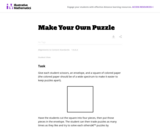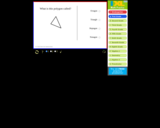
Brush up on your math skills relating to the area of parallelograms then try some practice problems to test your understanding.
- Subject:
- Mathematics
- Material Type:
- Reading
- Provider:
- IXL
- Date Added:
- 10/02/2022

Brush up on your math skills relating to the area of parallelograms then try some practice problems to test your understanding.

Brush up on your math skills relating to surface area then try some practice problems to test your understanding.

Learn about the properties of rectangles, rhombuses, and squares, and practice identifying them. Includes hints for questions. CCSS.Math.Content.3.G.A.1 Understand that shapes in different categories
Khan Academy learning modules include a Community space where users can ask questions and seek help from community members. Educators should consult with their Technology administrators to determine the use of Khan Academy learning modules in their classroom. Please review materials from external sites before sharing with students.

The instructional tool explores various geometric solids and their properties. Student can manipulate and color the different shapes. Learners examine the edges, faces, and vertices of the different solid figures.

This collection of resources for children ages 3-8 are drawn from the public television series Let's Learn, a partnership between the WNET Group and the New York City Department of Education. Let's Learn aims to provide our young learners with the knowledge and skills to learn and succeed during these challenging times. Our contributors create engaging, authentic, and interactive lessons that are accessible to students from their homes.

Spatial visualization is the study of two- and three-dimensional objects and the practice of mental manipulation of objects. Spatial visualization skills are important in a range of subjects and activities like mathematics, physics, engineering, art and sports! In this lesson, students are introduced to the concept of spatial visualization and measure their spatial visualization skills by taking the provided 12-question quiz. Following the lesson, students complete the four associated spatial visualization activities and then re-take the quiz to see how much their spatial visualization skills have improved.

Students learn about one-axis rotations, and specifically how to rotate objects both physically and mentally to understand the concept. They practice drawing one-axis rotations through a group exercise using cube blocks to create shapes and then drawing those shapes from various x-, y- and z-axis rotation perspectives on triangle-dot paper (isometric paper). They learn the right-hand rule to explore rotations of objects. A worksheet is provided. This activity is part of a multi-activity series towards improving spatial visualization skills.

A guide to support parents as they work with their students in analyzing, comparing, and composing shapes.

A guide to support parents as they work with their students in identifying, composing, and partitioning shapes.

The design project examines geometric shapes, color harmonies, and composition. An instructor sheet and student handout are included.

This instructional task gives students a hands-on experience with composing and decomposing geometric figures.

In this lesson, students will choreograph a figure for a square dance, graph it, and perform it. Media resources and teacher materials are included.

In this lesson, students use line segments, angles, and parallel and perpendicular lines in order to create a one point perspective drawing.

In this lesson, students will watch videos about shapes and identify shapes in their environment and in art. Links to the videos are at the bottom of the lesson overview, other material links are also provided.

In this lesson, students will identify 2- and 3-dimensional shapes as well as create shape drawings and sculptures. Teacher materials are available.

Investigate how a variety of shapes can be used to form composite figures using this interactive Learn Alberta math resource. Students will also work on using relevant operations and formulas to figure out the total area of composite figures. Be sure to follow the link to the printable activities, solutions, and learning strategies that are included to reinforce target skills.

This activity explores shapes and circles by encouraging children to look really hard at something they will see very often in the run-up to London 2012, and is designed to be accessible to primary pupils at Key Stage 1.

Sports such as hockey, football, basketball and tennis use balls of different sizes. Can you arrange a selection of different balls in a line each touching the next to make the shortest line? This activity offers opportunities for creative thinking and problem solving and helps pupils to understand the properties of circles. It can be presented using your school's own sports equipment and is aimed at primary school pupils (Key Stage 2).

Explore fractions through creating shapes in this interactive exercise.

Assess learning of polygons and perimeters with this interactive multiple choice practice and quiz activity. Click the question mark for hints.